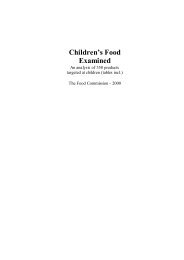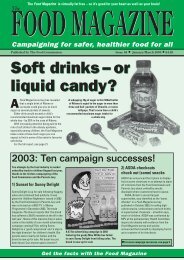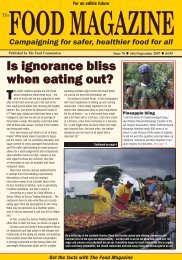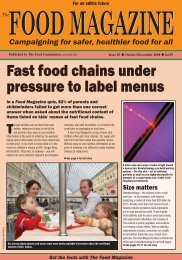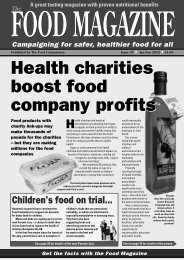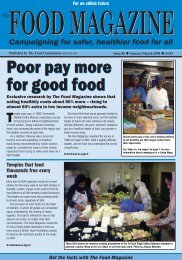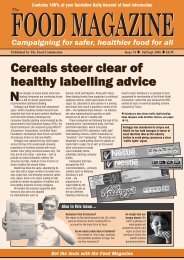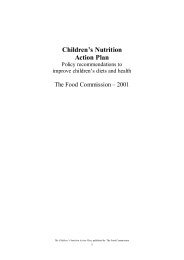Campaigning for safer, healthier food for all - The Food Commission
Campaigning for safer, healthier food for all - The Food Commission
Campaigning for safer, healthier food for all - The Food Commission
You also want an ePaper? Increase the reach of your titles
YUMPU automatically turns print PDFs into web optimized ePapers that Google loves.
sweeteners<br />
Aspartame: the litmus<br />
the FSA and EFSA<br />
Erik<br />
Millstone,<br />
Professor of<br />
Science<br />
Policy at the<br />
University of<br />
Sussex,<br />
warns that<br />
recent<br />
research into the artificial<br />
sweetener aspartame is being<br />
ignored by <strong>food</strong> regulators.<br />
Aspartame (often c<strong>all</strong>ed by its brand<br />
name Nutrasweet) has not only been<br />
one of the most controversial <strong>food</strong><br />
additives in the history of the industry, it has also<br />
been one of the most profitable. In autumn 2005<br />
the controversy intensified with the publication of<br />
the results of a long-term feeding study of<br />
aspartame conducted by the Ramazzini<br />
Foundation in Italy, indicating that aspartame<br />
caused a dose-related and statistic<strong>all</strong>y significant<br />
increase in the incidence of several types of<br />
tumour. 1 <strong>The</strong> significance of these results can<br />
only be appreciated if they are seen against the<br />
bizarre context of the aspartame saga.<br />
In the early 1970s, when the company<br />
seeking to market aspartame (G D Searle – and<br />
its subcontractor) was testing it <strong>for</strong> safety and/or<br />
toxicity, serious failings occurred in the conduct<br />
of those tests. <strong>The</strong>re is, <strong>for</strong> example, evidence of<br />
rats dying during the course of the experiment,<br />
but instead of being dissected in a search <strong>for</strong><br />
evidence that the test compound might have<br />
been responsible, they were discarded and<br />
replaced with other rats. <strong>The</strong> test material was<br />
not accurately characterised, and was not<br />
always properly mixed with the feed, so that<br />
some of the animals ate the basic diet but<br />
avoided the lumps of test compound. Serious<br />
shortcomings occurred in <strong>all</strong> 15 of the pivotal<br />
chronic (i.e. long-term) toxicology studies. Instead<br />
of acknowledging the mistakes and starting<br />
again, Searle submitted the data from the flawed<br />
studies. <strong>The</strong> errors were revealed by the diligent<br />
ef<strong>for</strong>ts of an heroic scientist, Adrian Gross at the<br />
US <strong>Food</strong> and Drug Administration (FDA).<br />
So much of Searle's scientific evidence was<br />
flawed, including that on two drug products<br />
Flagyl and Aldactone, that the Chief Lawyer at<br />
the <strong>Food</strong> and Drug Administration wrote in April<br />
1976 to the Federal Attorney (FA) in Chicago<br />
(Searle's HQ was in Illinois) instructing him to<br />
convene a Grand Jury to indict, then prosecute<br />
Searle. Shortly thereafter, the Chicago FA was<br />
invited to join the law firm Sidley & Austin that<br />
represented Searle. He accepted and the Searle<br />
legal process was suspended until a new FA<br />
came into post. He too was invited to join Sidley<br />
& Austin, and the process was delayed again.<br />
This continued until the Statute of Limitations<br />
expired, so no effective legal action was taken.<br />
Public pressure from scientists and<br />
campaigners <strong>for</strong>ced the FDA to experiment with<br />
what was c<strong>all</strong>ed a Public Board of Inquiry (PBoI)<br />
to adjudicate on at least some of the facts<br />
concerning the possibility that aspartame might<br />
cause brain cancer. <strong>The</strong> inquiry concluded in<br />
1980 that it was not satisfied that aspartame<br />
was acceptably safe, and that judgement was<br />
endorsed by at least five senior FDA<br />
toxicologists. Despite this, aspartame was<br />
licensed in the US by the new head of the FDA,<br />
under the incoming Reagan Administration, who<br />
shortly thereafter left the FDA and went to work<br />
<strong>for</strong> Nutrasweet's PR company. <strong>The</strong> sweetener<br />
was approved in the UK on the advice of the<br />
Committee on Toxicity, whose chairman had his<br />
laboratory indirectly funded by Searle, and was<br />
approved in Europe and by the World Health<br />
Organisation with the involvement of scientists<br />
with undeclared commercial links to Nutrasweet.<br />
After products containing aspartame reached<br />
the market, some consumers began reporting<br />
that they felt acute adverse effects. No-one<br />
knows the frequency with which such problems<br />
occur, but I estimate between 1% and 10% of<br />
consumers experience some adverse effects<br />
after ingesting aspartame. <strong>The</strong> most common<br />
symptoms are severe headaches and blurred<br />
vision, while, thankfully, epileptic-type seizures<br />
are rare. That evidence has repeatedly been<br />
dismissed offici<strong>all</strong>y as ‘anecdotal’, although the<br />
sufferers often report that occasion<strong>all</strong>y symptoms<br />
recur. And when they do, they discover that<br />
inadvertently they had consumed aspartame.<br />
In 1996 John Olney of Washington University<br />
St Louis, a noble veteran of the aspartame<br />
debate, published a paper reporting evidence that<br />
the introduction of aspartame had been<br />
responsible <strong>for</strong> an abrupt increase in the<br />
incidence of a particularly aggressive type of<br />
brain tumour, c<strong>all</strong>ed glioblastomas, in the US. 2<br />
His argument was rein<strong>for</strong>ced by evidence that<br />
the tumour type had also been conspicuous in<br />
one of the previous, though flawed, animal<br />
studies and by biochemical evidence indicating a<br />
mechanism through which aspartame could<br />
exert a carcinogenic effect. Predictably, the FDA<br />
and the US <strong>food</strong> industry discounted his<br />
analysis. In the UK and Europe it was offici<strong>all</strong>y<br />
discounted because similar patterns had not<br />
emerged in the data, but that is probably<br />
because the age-profile of people consuming<br />
artifici<strong>all</strong>y sweetened products differs between<br />
the US and this side of the Atlantic. In the UK<br />
and continental Europe, artifici<strong>all</strong>y sweetened<br />
products are predominantly consumed by<br />
younger people rather than by ‘senior citizens’,<br />
and it was the latter group that Olney argued<br />
were especi<strong>all</strong>y at risk.<br />
I and others have repeatedly c<strong>all</strong>ed <strong>for</strong> a<br />
repetition of the pivotal chronic toxicity tests on<br />
aspartame by independent scientists. Morando<br />
Soffritti and his colleagues at the Ramazzini<br />
Foundation in Italy have not just repeated the<br />
flawed tests, using the protocol preferred by the<br />
chemical industry. <strong>The</strong>y have substanti<strong>all</strong>y<br />
improved upon it. <strong>The</strong> Italian study, published in<br />
2005, did not use 400 rats, they used 900.<br />
Instead of testing the compound at three dose<br />
levels (plus a control group) they tested it at five<br />
dose levels (plus controls). Instead of killing the<br />
rats be<strong>for</strong>e they reached the ends of their<br />
average natural lives, the rats lived longer so that<br />
long-term effects could be studied. In these and<br />
many other ways, the Ramazzini study was<br />
more thorough, sensitive, reliable and relevant to<br />
human exposure than those conducted in<br />
accordance with conventional protocols.<br />
<strong>The</strong> safety of aspartame is offici<strong>all</strong>y 'under<br />
review'. Provisional comments from the <strong>Food</strong><br />
Standards Agency (FSA), its Committee on<br />
Carcinogenicity and the European <strong>Food</strong> Safety<br />
Authority (EFSA) have emphasised possible<br />
reasons <strong>for</strong> discounting the results of the<br />
Ramazzini study, which had indicated that<br />
aspartame causes statistic<strong>all</strong>y significant<br />
increases in the incidence of several types of<br />
cancers, as if they were a 'false positive', while<br />
they remained blind to the evidence that <strong>all</strong> the<br />
previous studies on which they have been relying<br />
are almost certainly false negatives. Aspartame<br />
represents a powerful litmus test <strong>for</strong> both the<br />
FSA and <strong>for</strong> the EFSA, but current indications<br />
<strong>Food</strong> Magazine 73 8<br />
Apr/Jun 2006



